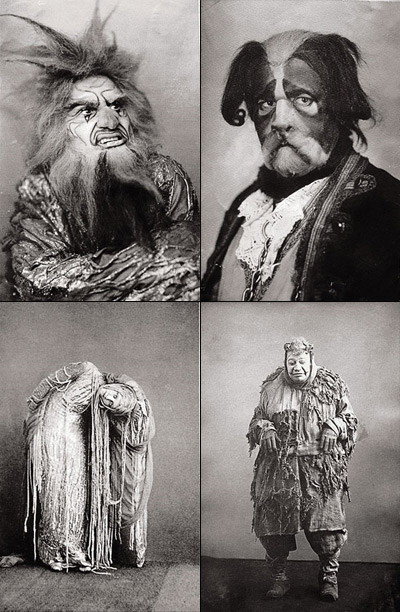Oscar Schlemmer
February 17, 2011 § 1 Comment

Oscar Schlemmer
Oscar Schlemmer was born in Stuttgard in 1888, since hisparents’ death around 1900 he had to learn to provide for himself from an early age.In 1903 he got an apprenticeship in a marquetry workshop. From 1905 to 1909 Oskar Schlemmer studied at the “Kunstgewerbeschule” as well as the “Akademie der Bildenden Künste” in Stuttgart, where he became Adolf Hölzel‘s master pupil in 1912.

He exhibited Herwarth Walden’s gallery “Der Sturm” in Berlin in 1919. After his marriage to Helena Tutein one year later, he was invited to Weimar by Gropius to run the sculpture department and the stage workshop at the Bauhaus. He also wanted to put his ideas about ballet into practice, and in 1922 he did so in public for the first time staging the famous Triadisches Ballett. He planned to free the stage from the trappings of tradition in order to give expression to the ‘pure idea.’ The central theme of his work was the problematic of the figure in space, and the mediator between these two was to be the dancer, stripped of his individual identity by the use of costumes and masks.Influenced by Cubism, he usually integrated this figures into geometric structures.

Oscar Schlemmer's "Triadisches Ballett". 1922

Until he left the Buhaus in 1929 his art can be seen as a manifesto for a robot society, both artistically, as it mocks the late-Romantic individualism of German painters such as Emil Nolde, and politically: in the wake of the Russian revolution a kind of machine communism was very alluring.
After his resignation from the Bauhaus he was given a professorship at the “Vereinigte Staatsschulen” in Berlin in 1932, but the National Socialists forced him to resign again in 1933.
During the War Oskar Schlemmer worked at the “Institut für Malstoffe” in Wuppertal together with Willi Baumeister and Georg Muche.

Oskar Schlemmer, House of Dr. Rabe, Zwenkau, 1930-31
He led a secluded life at the end of his career and made the small series of eighteen mystical “Fensterbilder” in 1942. Oskar Schlemmer was one of the most versatile artists of the 20th century.
Erich Consemuller's striking photograph of a woman wearing a painted metallic theatrical mask by Oskar Schlemmer and a dress made in the Bauhaus weaving workshop sitting on a Breuer tubular-steel club chair appears to be a half automaton. The blank look of the mask conveys both robotic and foreboding messages. Private collection. —Estate of Erich Consemuller photo
houdinismother
Rogério Reis
February 17, 2011 § Leave a comment
Rogério Reis was born in 1954, was educated at the Museum of Modern Art in Rio de Janeiro, among others. He has worked as a photographer since 1977. For the last 17 years he has spent a lot of time documenting , amongst other things, the various facets of the carnival in Rio de Janeiro. The carnival photographs have attracted a huge amount of attention in Brazil and abroad and have resulted in several exhibitions as well as a book titled “Na Lona” (On Canvas).




(+)
houdinismother
Janet Cardiff and George Bures Miller
January 13, 2011 § Leave a comment
Selina Baumann
January 11, 2011 § Leave a comment
Kris Kuksi
December 18, 2010 § 1 Comment
“A post-industrial Rococo master, Kris Kuksi obsessively arranges characters and architecture in asymmetric compositions with an exquisite sense of drama. Instead of stones and shells he uses screaming plastic soldiers, miniature engine blocks, towering spires and assorted debris to form his landscapes.
The political, spiritual and material conflict within these shrines is enacted under the calm gaze of remote deities and august statuary. Kuksi manages to evoke, at once, a sanctum and a mausoleum for our suffocated spirit.”




(+)
by houdinismother
Maeterlinck’s Premiere
December 11, 2010 § Leave a comment
In 1908, Maeterlinck premiered Blue Bird at Constantin Stanislavski‘s Moscow Art Theatre. Little remains but these stunning cartes de visite.
I asked Stanislavsky eagerly for photographs of scenes from “The Blue Bird” or else for the original designs of the scenic artist so that I might have them copied… the photographs, I was told, were not available – except those of the players themselves – for the originals had been made by Fischer, a German, and had been destroyed in the pogrom at the beginning of the war in 1914. And in the difficult times Russia has undergone since then, no others have been made. When I pressed my point and asked about the orignal designs, the firm, square but kindly face of my host carried a passing glance of embarassed modesty and then admitted that there were no designs. He had conceived them himself and had personally directed the artist, V. E. Yevgenoff, in the execution of the settings.
The Russian Theater Under the Revolution by Oliver Sayler,1920




(v)
houdinismother
Jeff Bark
December 10, 2010 § Leave a comment
This part of Jeff Bark’s work feels a lot like leafing through a diary of vices next door human beings indulge in.




(+)
dmtls
modern archaelogy
December 9, 2010 § Leave a comment
Some finds from the diverse and curious stock of Factory 20. Got [big] money to spend? Shop to your hearts content some really unique pieces

USA, 1920s, Vintage Strongman Circus Sledge Hammer. Solid old pine construction. Well worn patina. Solid and ready for use.

USA, c.1930s. Vintage Hypnosis Rotating Disc Machine. Dr. Hietrick's Vertigo Therapy. Bi-Directional Rotating Metal Disc. Fully Functional.

USA, c.1950s. Vintage Life Aquatic Exploration Ships Scuba Oxygen Breathing Tank. Appears to be Functioning.
the beast in beauty
December 9, 2010 § Leave a comment













